steering wheel DODGE CHALLENGER 2010 3.G Owner's Manual
[x] Cancel search | Manufacturer: DODGE, Model Year: 2010, Model line: CHALLENGER, Model: DODGE CHALLENGER 2010 3.GPages: 477, PDF Size: 4.79 MB
Page 287 of 477
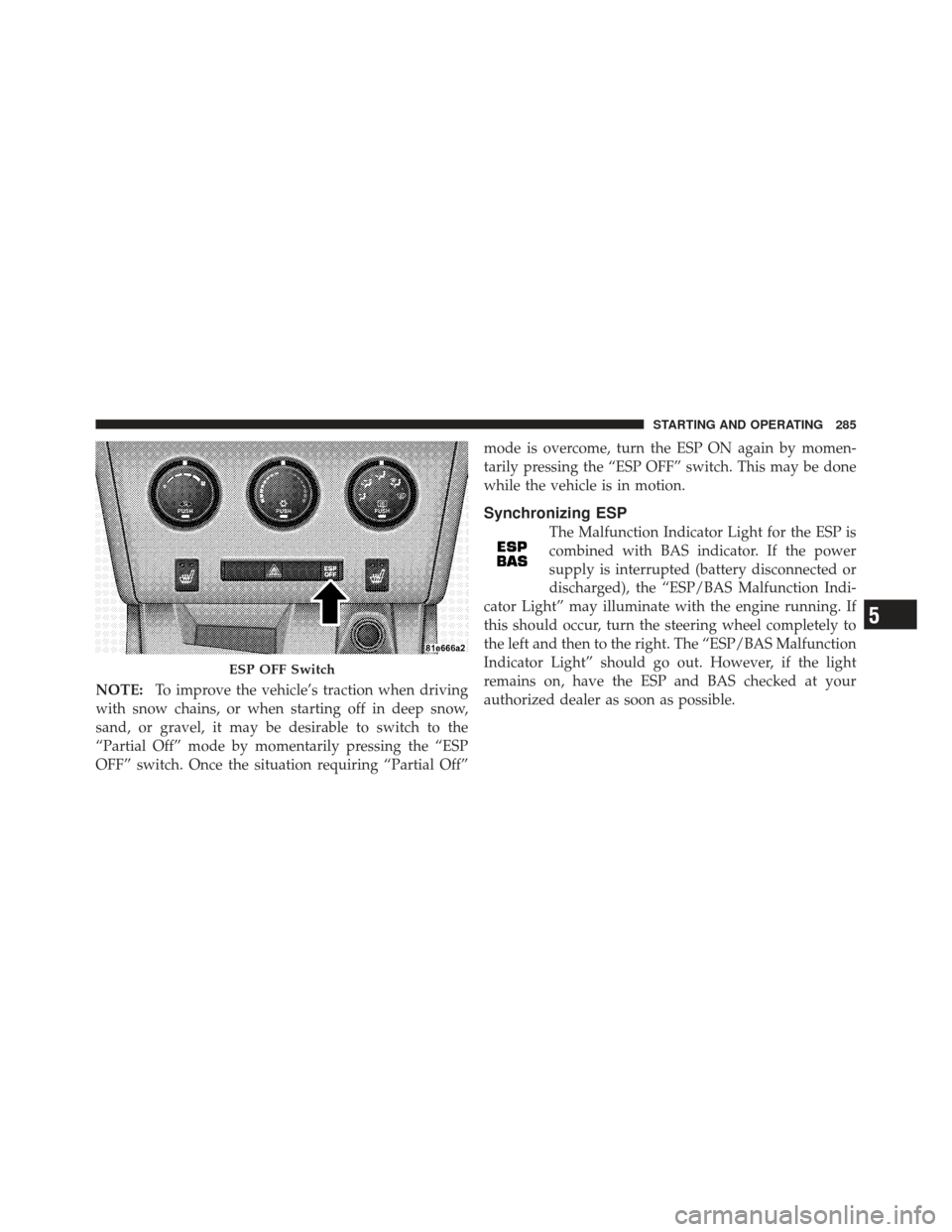
NOTE:To improve the vehicle’s traction when driving
with snow chains, or when starting off in deep snow,
sand, or gravel, it may be desirable to switch to the
“Partial Off” mode by momentarily pressing the “ESP
OFF” switch. Once the situation requiring “Partial Off” mode is overcome, turn the ESP ON again by momen-
tarily pressing the “ESP OFF” switch. This may be done
while the vehicle is in motion.
Synchronizing ESP
The Malfunction Indicator Light for the ESP is
combined with BAS indicator. If the power
supply is interrupted (battery disconnected or
discharged), the “ESP/BAS Malfunction Indi-
cator Light” may illuminate with the engine running. If
this should occur, turn the steering wheel completely to
the left and then to the right. The “ESP/BAS Malfunction
Indicator Light” should go out. However, if the light
remains on, have the ESP and BAS checked at your
authorized dealer as soon as possible.
ESP OFF Switch
5
STARTING AND OPERATING 285
Page 305 of 477
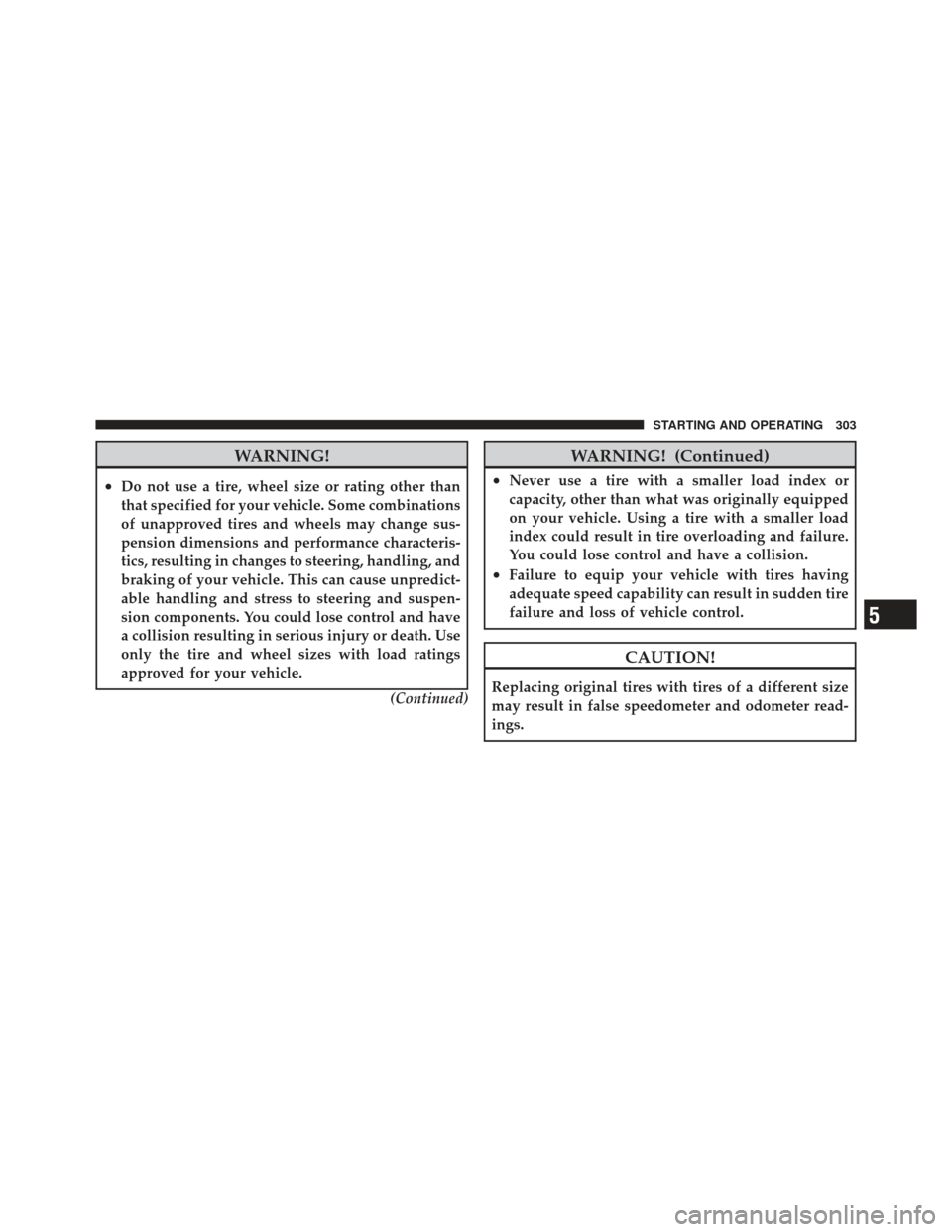
WARNING!
•Do not use a tire, wheel size or rating other than
that specified for your vehicle. Some combinations
of unapproved tires and wheels may change sus-
pension dimensions and performance characteris-
tics, resulting in changes to steering, handling, and
braking of your vehicle. This can cause unpredict-
able handling and stress to steering and suspen-
sion components. You could lose control and have
a collision resulting in serious injury or death. Use
only the tire and wheel sizes with load ratings
approved for your vehicle.(Continued)
WARNING! (Continued)
•Never use a tire with a smaller load index or
capacity, other than what was originally equipped
on your vehicle. Using a tire with a smaller load
index could result in tire overloading and failure.
You could lose control and have a collision.
•Failure to equip your vehicle with tires having
adequate speed capability can result in sudden tire
failure and loss of vehicle control.
CAUTION!
Replacing original tires with tires of a different size
may result in false speedometer and odometer read-
ings.
5
STARTING AND OPERATING 303
Page 332 of 477
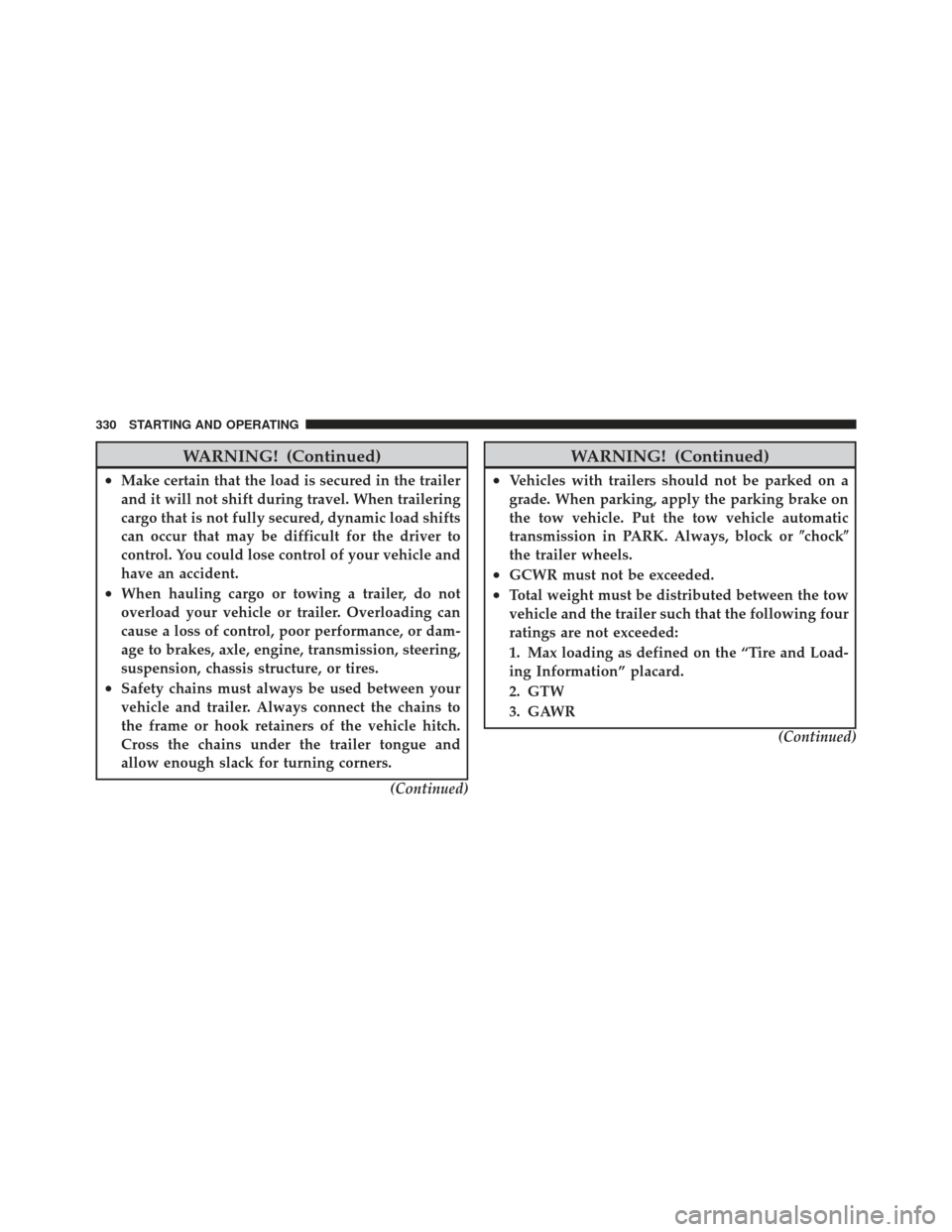
WARNING! (Continued)
•Make certain that the load is secured in the trailer
and it will not shift during travel. When trailering
cargo that is not fully secured, dynamic load shifts
can occur that may be difficult for the driver to
control. You could lose control of your vehicle and
have an accident.
•When hauling cargo or towing a trailer, do not
overload your vehicle or trailer. Overloading can
cause a loss of control, poor performance, or dam-
age to brakes, axle, engine, transmission, steering,
suspension, chassis structure, or tires.
•Safety chains must always be used between your
vehicle and trailer. Always connect the chains to
the frame or hook retainers of the vehicle hitch.
Cross the chains under the trailer tongue and
allow enough slack for turning corners.(Continued)
WARNING! (Continued)
•Vehicles with trailers should not be parked on a
grade. When parking, apply the parking brake on
the tow vehicle. Put the tow vehicle automatic
transmission in PARK. Always, block or \bchock\b
the trailer wheels.
•GCWR must not be exceeded.
•Total weight must be distributed between the tow
vehicle and the trailer such that the following four
ratings are not exceeded:
1. Max loading as defined on the “Tire and Load-
ing Information” placard.
2. GTW
3. GAWR
(Continued)
330 STARTING AND OPERATING
Page 367 of 477
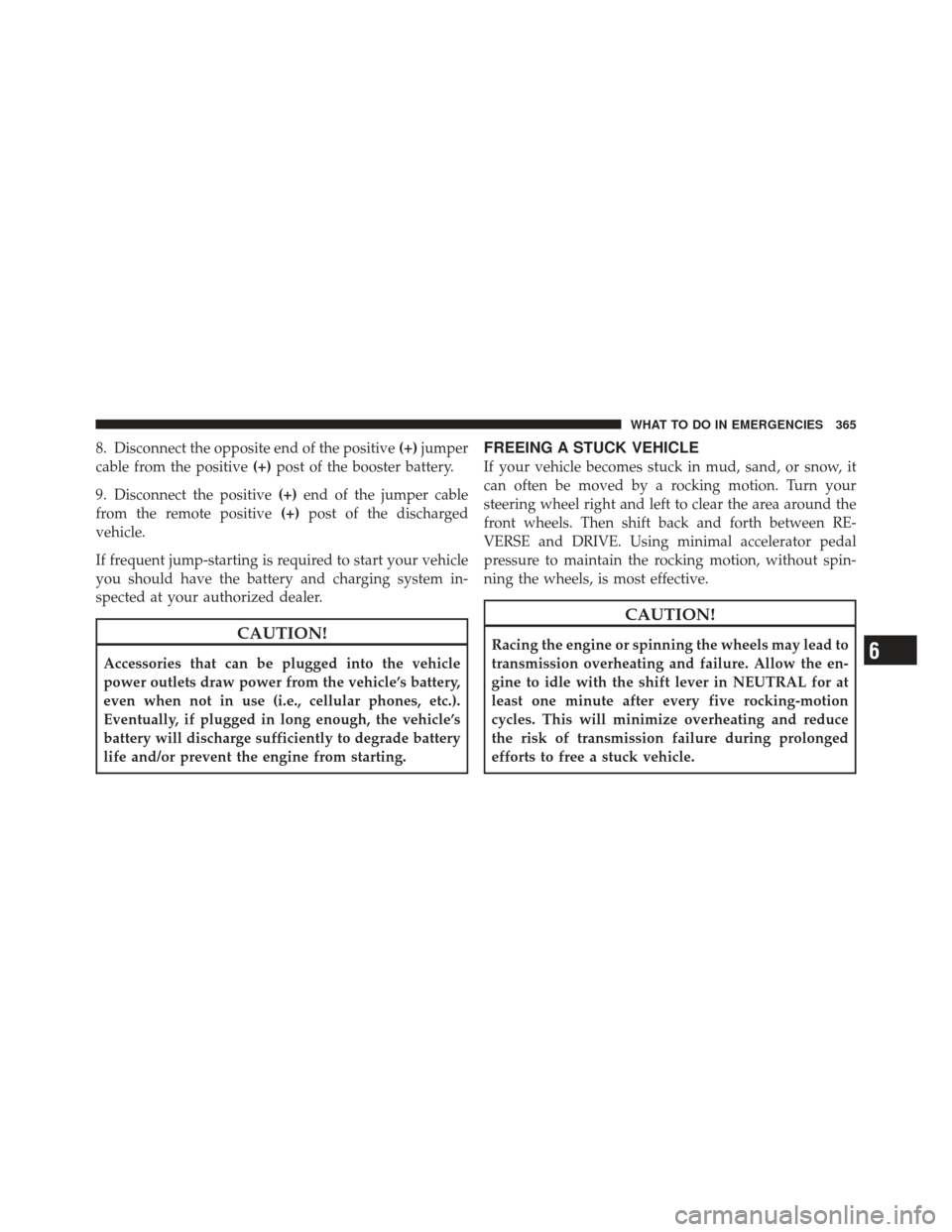
8. Disconnect the opposite end of the positive(+)jumper
cable from the positive (+)post of the booster battery.
9. Disconnect the positive (+)end of the jumper cable
from the remote positive (+)post of the discharged
vehicle.
If frequent jump-starting is required to start your vehicle
you should have the battery and charging system in-
spected at your authorized dealer.
CAUTION!
Accessories that can be plugged into the vehicle
power outlets draw power from the vehicle’s battery,
even when not in use (i.e., cellular phones, etc.).
Eventually, if plugged in long enough, the vehicle’s
battery will discharge sufficiently to degrade battery
life and/or prevent the engine from starting.
FREEING A STUCK VEHICLE
If your vehicle becomes stuck in mud, sand, or snow, it
can often be moved by a rocking motion. Turn your
steering wheel right and left to clear the area around the
front wheels. Then shift back and forth between RE-
VERSE and DRIVE. Using minimal accelerator pedal
pressure to maintain the rocking motion, without spin-
ning the wheels, is most effective.
CAUTION!
Racing the engine or spinning the wheels may lead to
transmission overheating and failure. Allow the en-
gine to idle with the shift lever in NEUTRAL for at
least one minute after every five rocking-motion
cycles. This will minimize overheating and reduce
the risk of transmission failure during prolonged
efforts to free a stuck vehicle.6
WHAT TO DO IN EMERGENCIES 365
Page 458 of 477
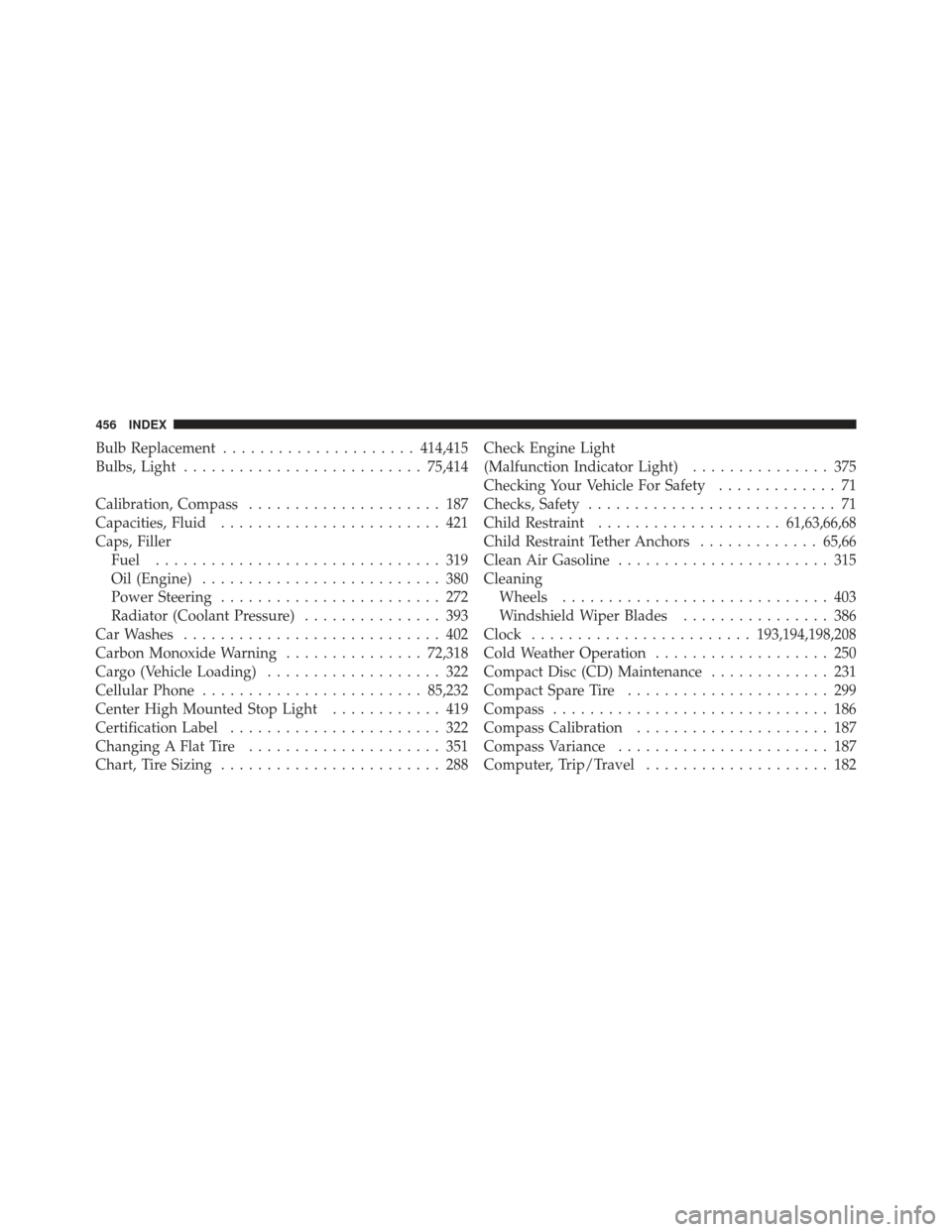
Bulb Replacement..................... 414,415
Bulbs, Light .......................... 75,414
Calibration, Compass ..................... 187
Capacities, Fluid ........................ 421
Caps, Filler Fuel ............................... 319
Oil (Engine) .......................... 380
Power Steering ........................ 272
Radiator (Coolant Pressure) ............... 393
Car Washes ............................ 402
Carbon Monoxide Warning ...............72,318
Cargo (Vehicle Loading) ................... 322
Cellular Phone ........................ 85,232
Center High Mounted Stop Light ............ 419
Certification Label ....................... 322
Changing A Flat Tire ..................... 351
Chart, Tire Sizing ........................ 288 Check Engine Light
(Malfunction Indicator Light)
............... 375
Checking Your Vehicle For Safety ............. 71
Checks, Safety ........................... 71
Child Restraint .................... 61,63,66,68
Child Restraint Tether Anchors .............65,66
Clean Air Gasoline ....................... 315
Cleaning Wheels ............................. 403
Windshield Wiper Blades ................ 386
Clock ........................ 193,194,198,208
Cold Weather Operation ................... 250
Compact Disc (CD) Maintenance ............. 231
Compact Spare Tire ...................... 299
Compass .............................. 186
Compass Calibration ..................... 187
Compass Variance ....................... 187
Computer, Trip/Travel .................... 182
456 INDEX
Page 472 of 477
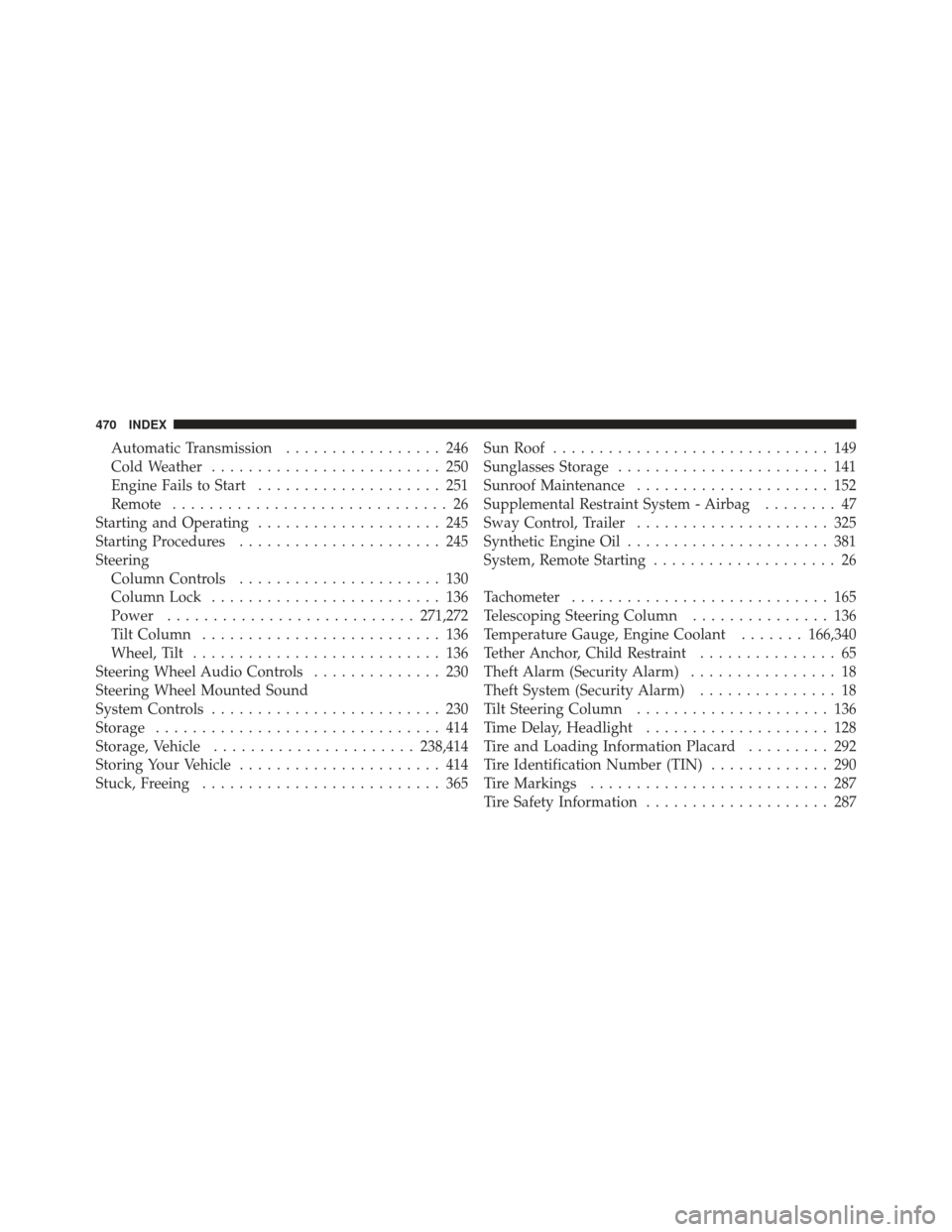
Automatic Transmission................. 246
Cold Weather ......................... 250
Engine Fails to Start .................... 251
Remote .............................. 26
Starting and Operating .................... 245
Starting Procedures ...................... 245
Steering Column Controls ...................... 130
Column Lock ......................... 136
Power ........................... 271,272
Tilt Column .......................... 136
Wheel, Tilt ........................... 136
Steering Wheel Audio Controls .............. 230
Steering Wheel Mounted Sound
System Controls ......................... 230
Storage ............................... 414
Storage, Vehicle ...................... 238,414
Storing Your Vehicle ...................... 414
Stuck, Freeing .......................... 365 Sun Roof
.............................. 149
Sunglasses Storage ....................... 141
Sunroof Maintenance ..................... 152
Supplemental Restraint System - Airbag ........ 47
Sway Control, Trailer ..................... 325
Synthetic Engine Oil ...................... 381
System, Remote Starting .................... 26
Tachometer ............................ 165
Telescoping Steering Column ............... 136
Temperature Gauge, Engine Coolant .......166,340
Tether Anchor, Child Restraint ............... 65
Theft Alarm (Security Alarm) ................ 18
Theft System (Security Alarm) ............... 18
Tilt Steering Column ..................... 136
Time Delay, Headlight .................... 128
Tire and Loading Information Placard ......... 292
Tire Identification Number (TIN) ............. 290
Tire Markings .......................... 287
Tire Safety Information .................... 287
470 INDEX